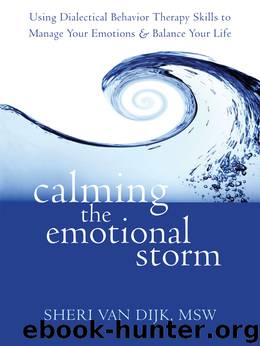Calming the emotional storm by Sheri Van Dijk

Author:Sheri Van Dijk
Language: eng
Format: epub
ISBN: 9781608820894
Publisher: New Harbinger Publications, Inc.
* * *
Levels of Validation
To make the idea of self-validation a little easier, you can break it down into three different levels: acknowledging, allowing, and understanding.
Acknowledging: The first and most basic level of self-validation is simply acknowledging the presence of the emotion: for example, “I feel anxious.” By just acknowledging the emotion, and putting a period on the end of that sentence rather than going down the road of judging it, you are validating your anxiety.
Allowing: The second level of self-validation is allowing, or giving yourself permission to feel the emotion: for example, “It’s okay that I feel anxious.” Here, not only are you not judging the emotion. You are going one step further, saying, “This is okay.” Again, this does not mean that you like the emotion or want it to hang around but that you’re allowed to feel it.
Understanding: The highest level of self-validation is, of course, the most difficult. In this form of validation, not only do you refrain from judging the emotion, and not only do you say it’s okay to feel it, but you go one step further and say you understand it: “It makes sense that I feel anxious being at home by myself, given the fact that I was at home alone when thieves broke in and threatened me with a gun.”
If you’ve been invalidating your emotions for most of your life, it’s likely that you’ll start out validating yourself at the first level, simply acknowledging the emotion that you feel. Even this may be difficult, so remember to have patience and keep practicing. Over time, you’ll find that you’re gradually able to move on to the next level and then to the next. It’s also natural that you’ll move at different speeds with different emotions. Perhaps it’s easier for you to validate anxiety, for example, than anger, and so you might be at the highest level of validation with your anxiety and still at the lowest level of validation with your anger. Wherever you find yourself, don’t judge it. Keep working at it, and it will come.
Here are some examples of validating statements, using anger as an example:
“I feel angry.”
“It’s okay that I feel angry right now.”
“I’m feeling angry. It’s uncomfortable, but it is what it is.”
“I’m feeling angry for a reason.”
“It makes sense that I’m feeling angry, because I just had a fight with my friend.”
“I’m feeling angry right now, but that doesn’t mean anything about me as a person.”
“It makes sense that I would have problems with my temper because of the environment I grew up in.”
Download
This site does not store any files on its server. We only index and link to content provided by other sites. Please contact the content providers to delete copyright contents if any and email us, we'll remove relevant links or contents immediately.
Should I Stay or Should I Go? by Ramani Durvasula(7621)
Why We Sleep: Unlocking the Power of Sleep and Dreams by Matthew Walker(6651)
Fear by Osho(4696)
Flow by Mihaly Csikszentmihalyi(4656)
Rising Strong by Brene Brown(4411)
Why We Sleep by Matthew Walker(4394)
The Hacking of the American Mind by Robert H. Lustig(4336)
How to Change Your Mind by Michael Pollan(4313)
Too Much and Not the Mood by Durga Chew-Bose(4301)
Lost Connections by Johann Hari(4134)
He's Just Not That Into You by Greg Behrendt & Liz Tuccillo(3856)
Evolve Your Brain by Joe Dispenza(3631)
The Courage to Be Disliked by Ichiro Kishimi & Fumitake Koga(3435)
Crazy Is My Superpower by A.J. Mendez Brooks(3358)
In Cold Blood by Truman Capote(3344)
Resisting Happiness by Matthew Kelly(3322)
What If This Were Enough? by Heather Havrilesky(3286)
The Book of Human Emotions by Tiffany Watt Smith(3265)
Descartes' Error by Antonio Damasio(3247)
